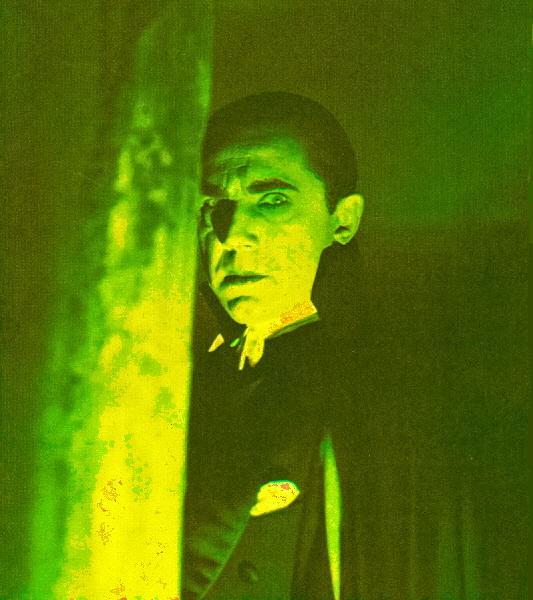
Edward Winter

No single article can provide an adequate picture of what certain chess writers have felt entitled to charge money for, and the present overview focuses on inaccuracy at its most elementary level: the inability to handle basic facts.
***
The Art of the Checkmate has a reference to ‘James Harry Blackburne, 1842-1926’. This should read Joseph Henry Blackburne, 1841-1924.
(19)
As mentioned in an endnote on pages 264-265 of Chess Explorations, the mistakes came from the French original of Renaud and Kahn’s book.
See too C.N. 9149, for a discussion of a ‘new 21st-Century Edition’ edition of the book, which has this:

Chess by Paul Langfield was published by Macdonald Guidelines (London) in 1978.
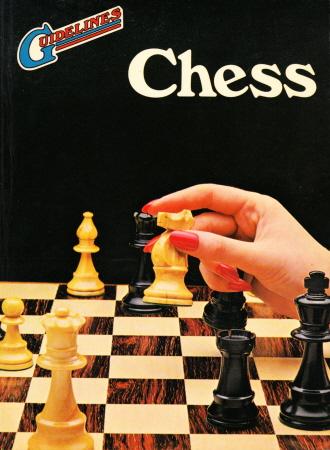
The closing section on ‘Great Chess Players’ is astonishing. There are biographical entries for B. Brinck-Claussen, Ricardo Calvo, Nicholaas Cortlever, Svend Hamann and Axel Ornstein, but nothing at all on Labourdonnais, Rubinstein or Steinitz ... In fairness it must be pointed out that the author does say, ‘The list is an arbitrary one, culled from the author’s own reading in the world of chess, so inevitably there will be ommissions [sic]. For these, humble apologies are offered’ (page 76). One wonders, though, what kind of author it can be whose own reading gives Axel Ornstein preference over Wilhelm Steinitz.
A number of chess monstrosities were listed last time. Our last word on the subject is to say that they are compounded by the author’s inability to write a clear English sentence. Some of the following are models of superficial content wrapped up in sloppy language (all the examples are taken from the glossary on pages 93-94):
The dust-jacket of Paul Langfield’s Chess Move by Move (New York, 1968) stated that he was born in Bristol in 1914 and was the author of The A-Z of Greenhouse Plants.
In the Year Book of Chess 1982-3 (British Chess Federation) it is sad to see that a major publisher (Dover) will take out a two-page advertisement to prove that it can misspell a good half-dozen of its authors’ names.
(335)
One might think that the Diccionario Enciclopédico Hispano-Americano (published in the late nineteenth and early twentieth centuries) led the field in misspelling chess masters’ names in view of its references to those well-known exponents Saunton, Andersen, Morphi, Von de Lassa and Saint Amande. Nonetheless that work is shown a clean pair of heels by another Spanish reference set, the Enciclopedia Universal Ilustrada, which informs us of such great players as Filidor, Deschapelle, Olorwitz, Marocsy, Makoevetz, etc. Some are misspelled twice, e.g. Charouseck/Charonsek and – our favourite – Pillsburg/Pillisburg. Brun means little until one thinks of Amos; for Cocock, think of problems and for Alarschall, presumably, swindles.
(481)

Only occasionally do books for novices give any indication of the existence of chess history, and it may therefore seem ungrateful to complain when, exceptionally, this does happen. However, a recent book from Oxford University Press deserves little mercy since it treats the history of the game with utter contempt.
The main problem is that J.N. Walker, the author of Chess for Tomorrow’s Champions, knows nothing about yesterday’s, but insists on writing about them. The book that he produces, well-nigh impeccable in its treatment of how to play chess, is a total shambles on ‘peripheral’ matters. Quite apart from factual errors and a distasteful liking for unsubstantiated trivia, the book evinces an astonishing lack of any historical judgment. From Philidor to Karpov everything is bungled.
Here are examples of how Walker sees things:
This is just a sample from a most slovenly book. The awkward question that J.N. Walker must answer to himself (it is probably too much to expect a public reply) is how he could possibly have been so unaware of his own limitations as to think himself capable of writing on chess history.
We are also writing privately to our old colleagues of Oxford University Press to record our dismay at the publication of Chess for Tomorrow’s Champions.
On 10 September 1994 John Walker sent us this letter:
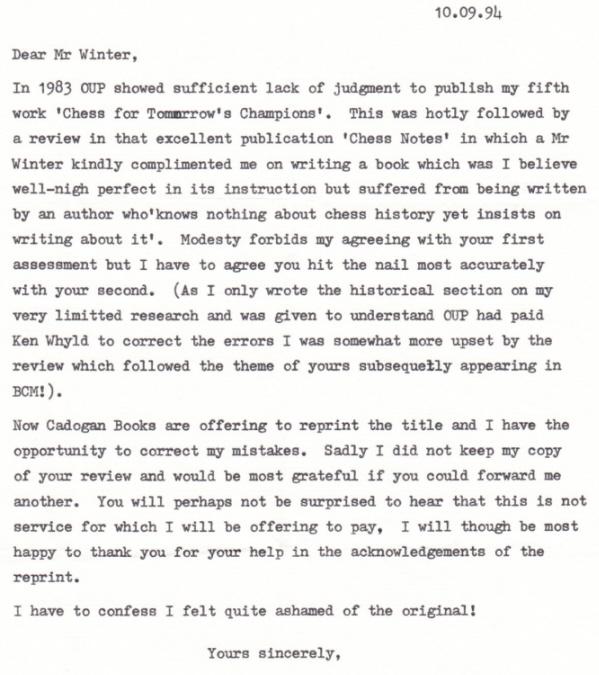
We provided the requested copy of the review but asked not to be mentioned in the new version. As noted on page 264 of Chess Explorations, the 1995 edition of Chess for Tomorrow’s Champions was better.
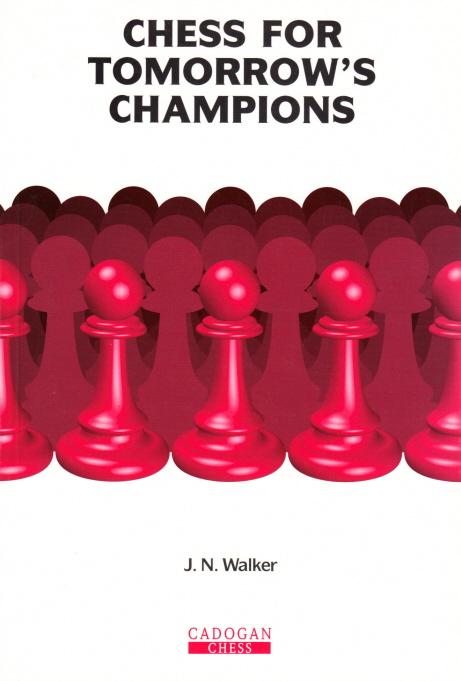
One might expect chess writers to be capable of reporting correctly the basic details of, at least, a famous event such as the 1927 world championship between Capablanca and Alekhine. It took place in Buenos Aires in 1927. There were 34 games, and Alekhine won with a score of +6 –3 =25.
On page 10 of 100 Classics of the Chessboard, A.S.M. Dickins and H. Ebert state that it took place in New York.
On page 163 of The Literature of Chess John Graham wrote: ‘The final result? Alekhine won by four games to three with 25 draws!’
On page 14 of Karpov-Korchnoi 1978 by Raymond Keene: ‘Matches varied in length from ten games (Lasker-Schlechter 1910) to 35 (Capablanca-Alekhine 1927).’
Ibid., page 124: ‘Most commentators were predicting a long match and the record of 35 games held by Capablanca v Alekhine 1927 appeared in danger.’
Ibid., page 138: ‘... the 35 games of the 1927 Capablanca-Alekhine match’.
Page 50 of the Larousse du jeu d’échecs states that the match lasted three months, and page 371 says that Alekhine was proclaimed world champion after the 27th match-game.
(585, 889 & 1015)
We have just been re-reading Emanuel Lasker, The Life of a Chess Master by J. Hannak (London, 1959), ‘translated’ into English by Heinrich Fraenkel, an unreliable work.
To justify our remark, we take as an example a single page (page 27):
a) misspelling ‘concurrant’.
b) ‘Samuel Hoffer, Chess Editor of The Field ...’ Leopold would be correct. (Translator’s mistake.)
c) (At Amsterdam, 1889, Lasker ... ) ‘lost the decisive game against the British master Burn.’ Not so. In fact, Lasker never lost to Burn.
d) ‘For the first time in his life Lasker crossed the German border and got the thrill and experience of being abroad in a foreign land.’ (So much more thrilling than being abroad at home ...)
e) ‘Nor was he to fare any better when, early in 1890, he went to compete in a small Austrian tournament at Graz.’ ‘Late in 1890’ would be more exact since the event took place in September.
f) ‘True, he didn’t lose a game.’ Untrue, he did.
Not bad for one page.
(776)
One need look no further than the game-headings in the
four-volume translation Herencia Ajedrecística de Alekhine
by A. Kotov:
Tinner-Alekhine, Podebrad, 1936; Bad Naugheim, 1937; Kebitz; Scheveninguen (a dubious Spanish ‘transliteration’?); Magret, 1937; Match-Alekhine, Hamburg, 1930; Alekhine-Seitz, Hastings 1926-27 (neither player was in that tourney); Alekhine-Seitz, London, 1922 (Seitz was not there – Yates is meant); Brandley Beach, 1929; Apchenek; Mogreb, 1938; Bradly-Beach.
But the best, and one that says it all, is on page 86 of the second volume: Marco-Alekhine, Gaaga, 1921.
From The Annual Obituary 1981 (a New York publication), page 207:
[Edward Lasker competed ...] ‘against Alexander Alekhine in 1913 at an exhibition in Paris. Alekhine, who emerged the victor, described the game’s strategy as “the Vienna Game”. The next year “Lasker Minor” played “Lasker Major” at the international tournament in St Petersburg and the elder champion won the match, retaining the world championship until he was defeated in a famous battle with Capablanca in Havana in 1921.’
It is also revealed regarding Edward Lasker:
‘He witnessed the Bobby Fischer-Boris Spassky matches in Helsinki in 1972.’
(872)
Hugh Myers (Davenport, IA, USA) writes to us in connection with The Literature of Chess by John Graham (published by McFarland & Company, Inc., 1984):
‘At the end of his long and favourable review of Horowitz’s The World Chess Championship: A History, Graham says (about Horowitz): “I hope he produces another book in a few years to continue the story to the present.” Not likely.’ [Horowitz had died in 1973.]
Among the scores of other errors in Graham’s book is this passage on page 127:
‘In 1936, at 68, he [Emanuel Lasker] played in the Nottingham tournament. In the opening stages he led the field of the best in the world. However his age eventually told and he finished in eighth place. This was hardly a poor performance since four of the places above him were filled by world champions of the future!’
In the next paragraph, Graham writes:
‘His life ended in 1940, still playing chess, this time in the middle of a match against his old rival Marshall, a match destined to remain unfinished.’
Lasker died in 1941.
From a review of Bobby Fischer Teaches Chess on pages 26-27 of that wretched book The Literature of Chess by John Graham:
Page 26: ‘The book is confusing!’
Page 27: ‘an ideal gift for a beginner’.
A further sample showing Mr Graham’s unique grasp of his subject:
Page 49: (on a Horowitz openings book): ‘This is, at first sight, a massive volume (790 pages), which simply duplicates the MCO by presenting all playable lines of all chess openings.’
Page 74: (regarding Modern Ideas in Chess): ‘The word “modern” refers to 1942 when Réti first recorded these ideas.’ Réti died in 1929.
Page 75: we learn that Tarrasch was a hypermodern player.
Page 89: (on Nimzowitsch): ‘He has [sic] not much of an author.’
Page 132: Morphy ‘visited Paris in 1867 during the American Civil War’.
Page 161: ‘Anderssen was given recognition as the best after Morphy’s death.’ Anderssen predeceased Morphy by five years.
Page 175: Reinfeld’s Great Games by Chess Prodigies: half-way through the review, Graham starts calling the author Horowitz.
Page 184: ‘Alekhine died in Spain.’ (Same error on page 211.)
Page 189: Botvinnik’s One Hundred Selected Games: ‘Curiously, in 1936 he does not mention the Nottingham Tournament ...’ Curiously, he does in our copy.
One could give countless examples of misspellings of names, and Graham’s remarks on translating (page 141) and a Roizman book (‘An understanding of Russian limited to recognition of Cyrillic characters is sufficient to decipher players’ names, but not enough to read annotations’ – page 158) are sufficient proof that he is no linguist. Blending in with all this are the author’s criticisms of the writing of others. On page 179 we are warned to treat a book ‘with circumspection. There are errors.’ Another title (page 196) is sternly rebuked: ‘More care should have been taken in publishing. There are several mistakes.’
(889)
An endnote on page 266 of Chess Explorations:
C.N. 889 listed nearly three pages of mistakes in The Literature of Chess, one of the least accurate chess books.
From Hugh Myers (Davenport, IA, USA):
‘I was looking up a game in Chess Digest’s 1973 book of San Remo, 1930 and I noticed that they correctly spelled the names of some of the participants! Some people might argue about Tartacover and having both Nimzovich and Nimzovitch. Not me. But it’s remarkable to see Alekine (aren’t Alekhine, Alekhin and Aljechin enough to select from?), Bogolubov, Rubenstein (also Reubenstein), Araisa (for Araiza ), Montichelli (for Monticelli), Knoch (but that one’s an isolated typo) and Spielman. Is this a record for one tournament book (not counting books published in Spain, which can be other-worldly)? The Chess Digest book credits Mr Bob Mapes for proofreading and “final corrections”. I can’t decide who deserves the most special recognition as a proofreader, Mr Mapes or Mr David Daniels of MC0-12 (e.g. Pirć, Bareza and “Map Large” for Max Lange).’
(1022)
One book we most certainly shall not be reviewing in full is Grüenfeld Defense, Russian Variations by Eric Schiller, published by Chess Enterprises.
Grüenfeld is the novel spelling on the front cover. The back cover and spine prefer Gruenfeld. The Preface gives Grünfeld. The bibliography has Bruenfeld.
Ah yes, the bibliography, with its reference to the 1946 edition of Modern Chess Openings by ‘Griffith, P.C. & E.W. Sergeant’. P.C. Griffiths cannot be meant, since in 1946 he was not writing, he was being born. Presumably Mr Schiller was not sure whether the co-author was E.G. Sergeant or P.W. Sergeant, so he took one initial from each.
All this, though, is a mere antipasto, leading in to our tentative nomination for the most crass couple of sentences of 1985:
‘Dedication
To Harry Golombek, a friend and mentor, whose vast knowledge of chess, arbitin, and foreign languages I hop to someday acquire. May my writing retain its vitality as long as his has!’
As printed ...
(1054)
A Pergamon book, Play the Bogo-Indian, has a brief ‘Historical Introduction’ that confirms our increasing doubts about the writing skills of S. Taulbut. Bogoljubow himself is represented by one single (atypical) game, against Grunfeld (no umlaut, of course) at Marienbad, 1925. The game must be ranked as one of B.’s most remarkable achievements, given that he did not even play in that tournament. But, then, Marienbad, Breslau, what is the difference? For good measure, a note at move 21 is misplaced. The next game is played at ‘International, Prague, 1937’, followed a little later by one at ‘Los Palmas’. Warmly recommended too is the Korchnoi-Andersson game on page 44, played at ‘Wiju Aram Zee’.
(1006)
In C.N. 1243 (see page 161 of Chess Explorations) W.D. Rubinstein drew attention to a booklet published in Madras in the mid-1980s, Karpov’s Best Games by V. Ravi Kumar (or Ravikumar). From the author’s introduction, entitled ‘Karpov “The Man Machine”’, a few sentences (to use that noun loosely) were quoted:
‘He was awarded the Chess Oscar for his outstanding achievements in Chess. A honour which he won many times in succession Karpov is a Solid Positional Master but if the situation warrants he can glar himself to a tactical Genious. In the chapters that follows of his selected Games from 1980 to 1984 are annotated with my own notes for your entertainment.’
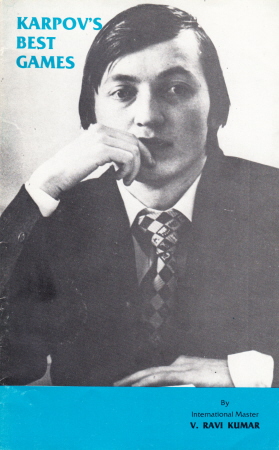
Alan Slomson (Leeds, England) writes:
‘I would like to suggest that you institute a “Historical Blunder of the Year” Competition. For this, I should like to nominate the following extract from the book Kasparov v Karpov, published by Chequers:
“Not since the inaugural world championship match of 1886 had the players been required to move house in the middle of the battle.” (Note before Game 13)
This mistake is particularly remarkable since I doubt whether many people carry in their head the venues of all the world championship matches, and any recourse to a reference book would be bound to show the error of this statement.’
Any other bungled history nominations? Our José Alexandrovich Lasker award awaits the proud winner.
(1316)
From page 155 of the February 1907 issue of the Chess Amateur:
‘Emanuel Lasker, who now particularly is attracting world-wide attention, was born in Brussels in 1869, and was first heard of as a public player in 1889, having, in that year, carried off first prizes in a tournament held at the Kaiserhoff, in Berlin, without the loss of a game.’
No special effort is required to find four or five mistakes there.
(1407)
The magazine Gens una sumus, edited by Dimitrije Bjelica, first appeared after the 1986 Dubai Olympiad. Issue 2-3 is dated July 1987. The two issues contain a spectacular historical article by D.B. entitled ‘Kings of Chess’ in which the reader is introduced to such greats of the golden era as Blackbern, Dikon, Mongredijen, Grin, Anderson, Berd (Henri Eduard), Blackburn, Zuckertot, Vinaver, Mekenzy, Golmaj, Martines, Bahman, Janevski, Sesil de Vara, Andersen, Kolis, Levental, Harvik, Tarash, Pilsbery, Lloyd, Zueckertot, Charusek, Frenk Marshal, Byrne, Gunsburg, Mizes, Minoti, Li, Kiesericky, Cukertot, Mesona, Marocia, Marozi.
There is less fantasy with the modern masters, although the first issue does have an article by ‘Pol Banko, Granmster (USA)’.
(1695)

Page 425 of the September 1988 Scacco offers a quiz based on six Capablanca positions. All six contain mistakes (wrong positions, players, dates, venues). Once again it is the dreaded Informator book Encyclopaedia of Chess Middlegames (Belgrade, 1980) that is behind the disarray. See page 200 of the May 1985 BCM.
(1785)
An endnote on page 267 of Chess Explorations:
Slaphappy writers continue to copy mistakes from the Encyclopaedia of Chess Middlegames. See, for instance, the treatment of Capablanca’s games in Chess Combinations of The World Champions by Eric Tangborn (Dallas, 1994) and The Big Book of Combinations by Eric Schiller (San Francisco, 1994).
Regarding Eric Schiller’s use of the Encyclopaedia, see too Copying.
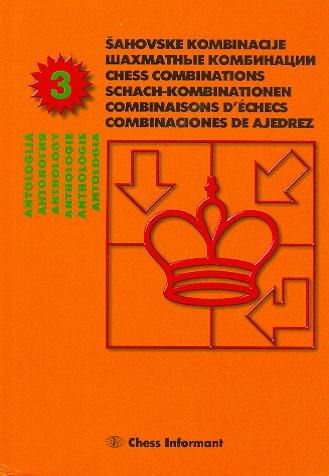
In common with its two predecessors (published in 1980 and 1995) Anthology of Chess Combinations (Belgrade, 2005) makes little effort to attach accurate names, dates or places to the combinations on display. After everything written in readily available sources, how can the Chess Informant team believe that Glucksberg v Najdorf was played in the 1935 Warsaw Olympiad? Or that there was a game ‘F. Parr – Waitkroft’ in 1968? Or that Morphy had an opponent named ‘Morian’? Or that Botvinnik’s brilliancy against Capablanca at AVRO, 1938 was played in Amsterdam?
Such a list of elementary matters could be prolonged almost endlessly, but to what effect? We would, though, draw attention to the Chess Informant’s sense of balance; in the 2,709 combinations Emanuel Lasker is featured just once (a loss) and Capablanca only twice (two losses).
(4061)
Chess Trivia by Peter Hotton and Herbert A. Kenny (Quinlan Press, $7.95) is a series of quizzes, the standard of which can be gauged from the following sample with our comments in brackets:
Page 1: ‘What is the Udemann Code?’ (A misprint for Uedemann Code.)
Page 3: ‘What master once stood on his head between moves in a match? Nimzovitsch.’
Page 4: ‘What is axedras? The Spanish word for chess.’ (Chess in Spanish is ajedrez.)
Pages 4/13: ‘What is a fingerfelter?’ (A slip of the hand when typing Fingerfehler.)
Page 6: ‘What is the etymology of the word “gambit”? It is from the French cambi, meaning “exchange”.’ (It is from the Italian gambetta. French has no word cambi.)
Page 12: ‘Sam Lloyd’. (The Welsh puzzle king ...)
Page 21: ‘What master once stood on his head between moves in a tournament? Nimzovitsch.’ (So, once in a match and once in a tournament.)
Page 23: ‘What American chess master has written the most books about the game? Irving Chernev.’
Page 26 (and passim): ‘Rubenstein’.
Page 28: ‘What British champion conducts the chess column in the Manchester Guardian? Leonard Bardon.’ (The Manchester Guardian changed its name decades ago, but Barden has yet to change his.)
Page 31: ‘James Mason of Killarney.’ (Kilkenny.)
Page 32: ‘A.L.H. Deschappeles (1780-1842)’. (Evidently unrelated to A.L.H. Deschapelles (1780-1847) or to ‘Alexander Deschappelles’ further down the same page.)
Pages 39/49: (We are told that Steinitz was officially world champion for ten years, but claimed the title for 30 years, and that he was succeeded by Lasker, who was world champion for 30 years, from 1897 to 1927.)
Page 50: (‘Schlecter’, who, page 32 had claimed, died in 1916.)
Page 96: ‘What twentieth-century player was called the “crown prince of chess”? Keres.’ (Not Nimzowitsch, of course, whose match and tournament posture precluded crowning.)
Page 106: O’Kelly ‘is the only grandmaster who is a member of the nobility’. (He died in 1980.)
Page 112: ‘Who’s the world champion in 1983? Kasparov.’
Page 124: Euwe ‘world champion in 1948’.
Page 125: Botvinnik ‘world champion in 1950’.
It is like that from start to finish. ‘Emmanuel (and Emmanual) Lasker’, ‘Herman Helms’, ‘Paul Benko’, ‘Giovannie Leonardo’, ‘Paulson ’, ‘Compomanes’, ‘Taimonov’, ‘Olgan Menchik’, ‘Scheveninger system’, ‘en pris’, ‘William Tevis’, ‘The London Illustrated News’, ‘LaPalemede’, etc., etc., etc.
(1821)
Tentative nomination for the chess book with the most misspellings of players’ names: Traité du jeu des échecs by Jean Taubenhaus (Paris, 1910). For example, pages 222-223 alone refer to de Rivièr, Andersen, Teichman, Maison, Tarrasche, Mises, Zuckertort, Levis, Marocy, Veiss, Jaowski, Vinaver, Lepchitz, Soldatenkor, Benstock, Forgace, Snosko-Borouski, Holperin, Salve, Zukerlort, Blackburn, Marschal, Nuzio, Cochran, Kieseritzki and Chotard.
The proofreader is apparently still alive and working on books by Dimitrije Bjelica.
(2212)
Seldom have we seen as many incorrect names as in The Steeplechase by V. Charushin (published by Pickard & Son, 1999). From the dozens of instances here are just a few: three consecutive games misspell the name of Alekhine’s opponents (pages 24-25); nineteenth-century games against Jaenisch and Bilguer are ascribed to the twentieth-century player F. Lazard; page 49 has a Morphy game against ‘Sharpautje’ instead of Le Carpentier.
(2371)
The Mammoth Book of Chess by Graham Burgess (published by Robinson, 1997) has a number of qualities, but painstaking accuracy is not among them. A magazine title (page 126) is just as likely to be misspelt as a master’s name (e g. the game on page 200, which has mistakes for both players) or the name of a publisher (page 528). Graham Burgess is badly out of touch with chess history if he believes that Capablanca’s opponent (page 65) was ‘Tanarov’ (instead of Fonaroff) or that (page 239) the Cuban lost a tournament game in 11 moves. Another mysterious blunder is ‘Alekhine-Drewitt, Dortmund, 1923’ (page 296). The game was played in Portsmouth and is in Alekhine’s first volume of Best Games. Mr Burgess is also two years out with Steinitz’s year of birth (page 495) and, on the next page, one year adrift over Tal’s year of death.
(Kingpin, 1998)
An extract from our discussion of The Batsford Chess Encyclopedia by Nathan Divinsky (London, 1990):
Hübner’s name is spelt three different ways in the book’s first 31 pages. Page 2 refers to the ‘Suisse’ (instead of Sousse) Interzonal of 1967. Other assorted misspellings include ‘Teichman’, ‘Le Lionnaires’ (instead of Le Lionnais), ‘Kerchnoi’, ‘Nimjowitsch’, ‘English’ (for Englisch), ‘Boundarevsky’, ‘Duz Khotmirsky’, ‘Du-Duz-Khotimirsky’, ‘Blackburn’, ‘Card’ (Caro), ‘zugswang’, ‘Anderseen’, ‘The Philodorian’, ‘Philador’s Legacy’ and many more. Some foreign accents are put on once in a while, but most never at all.
Alessandro Nizzola (Mantova, Italy) points out this translator’s note about Schlechter on page 119 of Nimzowitsch’s La Pratica del Mio Sistema (Milan, 1987):
‘For the record: the Austrian master starved to death in his home city of Vienna on Christmas Day 1917.’
For the record: wrong city, wrong country, wrong day, wrong year.
(2396)
Ed Tassinari (Scarsdale, NY, USA) has sent us a photocopy of the New York Times obituary (28 March 1993) of Reuben Fine by Harold Schonberg. To quote just one example of the characteristic Schonbergery, we are informed that Alekhine and Capablanca shared first prize at Nottingham, 1936 and that Fine and Reshevsky were equal second.
(Kingpin, 1993)
From Who Was Who in America 1897-1942 volume (page 974):
‘PILLSBURY ... won world’s championship at Hastings Internat. Chess Congress, Eng., Sept. 1795.’
(598)
Dale Brandreth has published a scrapbook entitled Chess Columns 1924 & 1925. Most of the items come from the Washington Post (column conducted by W.H. Mutchler) and the Brooklyn Daily Eagle (H. Helms). Not all of the reportage is of choice quality, and one of Mutchler’s columns (on page 6 of the scrapbook) even records:
‘When Philidor conducted three games sans voir, the populace of the fifteenth century entered it in the encyclopedias as miraculous.’
(2996)
Nimzowitsch was ‘one of the great masters of nineteenth century chess’.
(From an article by David Spanier on pages 42-44 of the British Airways magazine High Life, May 1992.)
(Kingpin, 1993)
‘Chess games were first recorded towards the end of the eighteenth century.’
Raymond Keene, The Times, 16 November 1991 (Saturday Review, page 53).
(Kingpin, 1993)
Another writer whose concern about chess history is seemingly limited to its name-dropping potential has now come up with: ‘the 19th century master Siegbert Tarrasch’.
Source: page 2 of Nigel Short: Quest for the Crown by Cathy Forbes.
(Kingpin, 1993-94)
Breezy indifference to facts is so prevalent nowadays that authors often fail even to place dates in their correct century. A bizarre instance from our recent reading concerns the 1860s game in Leipzig between Paulsen and Schneider. It has been widely published (e.g. in The Golden Treasury of Chess), yet that all-too-fallible book Play The Evans Gambit by T. Harding and B. Cafferty (Cadogan Chess, 1997) refers (on page 162) to ‘Paulssen-Schneider, Leipzig, 1983’.
This is naturally a field in which Eric Schiller has something to offer. For example, page 313 of his blunderful book Encyclopedia of Chess Wisdom (Cardoza Publishing, 1999) gives Legall’s famous brevity (5 Nxe5) as having been played in 1801 (i.e. nearly a decade after his death), and page 335 presents ‘Congdon vs. Delmar, New York 1980’ instead of 1880.
In the same book Schiller cautions, ‘We must be careful not to believe everything we read …’ That appears on page 351 but would have been better on the front cover.
(2255)
Now we add the following from page 6 of Make Your Own Chess Set by David Carroll (Englewood Cliffs, 1974):
‘Gradually the modern game emerged and developed. By the nineteenth century, masters like Morphy, Capablanca and Lasker were giving chess a heritage and were helped by the efforts of such men as Alexander Alekhine ...’
(4823)
Another specimen:
‘Caissa is the Muse of Chess and was the creation of Sir William Jones, a famous seventeenth-century orientalist.’
Source: page 189 of The Chess Scene by D. Levy and S. Reuben (London, 1974).
(6120)
See also C.N. 5109 (concerning Blackburne).
The following was given on page 302 of Kings, Commoners and Knaves:
An excerpt from page 19 of “En Passant” Chess Games and Studies by George Koltanowski (Edinburgh, 1937):
‘When Philidor, the Frenchman, in 1816 played six games blindfold the Press went mad, thinking it an eighth wonder …’
It certainly would have been. Philidor had died in 1795.
Which English-language chess book features the poorest prose? A front-runner must be Modern Analysis of the Chess Openings by Frank J. Marshall (published by J.R. Vrolijk, Amsterdam, undated but 1912/13).
Some examples:
‘I know my style is not as sound as the modern school calls for, still I have had few regrets when I was not successful, for to have been told after the play. “It was a fine try or a very pretty game”, buoyants one up and many times more than compensates for the loss.’ (Introduction, page 7)
‘Be careful about pawns. To move one for to attack with is better, than to have to move one for to defend with.’ (page 15)
‘A move to which I have given quite some study to, is instead of the text, 4 ..... 4. Kt‑Q5, it is also greatly favored by Teichman, and as Rubinstein in his game with Spielman shows it cannot be triffled with.’ (Regarding 4...Nd4 in the Four Knights’ Game, page 50.)
An (at least partial) explanation of this clutter is provided by the notice which appeared on page 151 of the July 1913 American Chess Bulletin:
‘Mr Marshall tells us that he was exceptionally unfortunate in the preparation of this work in that, after mailing the original manuscript from England to a printer in Holland, he saw no more of it, nor any proofs, until it reached him in book form! That the technical matter should prove so correct is little short of a marvel.’
(Kingpin, 1993-94)
A sample section from our feature article on World Champion Combinations by Keene and Schiller:
For the benefit of anyone lucky enough not to have seen the book the best way of showing the extent of the shambles is to pick a complete chapter and to examine every game and position given.
Chapter 6, dealing with Capablanca, has six games and four positions:
- Réti-Capablanca, Berlin, 1928. A one-sentence note at move 10 reads ‘White miscalculates and Black won’t be able to take advantage of the exposed queen’. That is the exact opposite of the intended meaning; ‘and’ should read ‘that’. (This time it is a case of unsuccessful copying from page 58 of Schiller’s 1997 companion volume, World Champion Openings.) There is also an inaccurate concluding note. Following 17…Bf3 it is stated, ‘The sacrifice must be accepted, or else …Qh3 is an easy win’. Yet after 18 gxf3, the move 18…Qh3 was indeed played, with such an easy win that Réti at once resigned.
- Capablanca-Havasi, Budapest, 1928. In the note after Black’s 7th move, reference is made to Capablanca-Bogoljubow, Moscow, 1925: ‘… according to Golombek, Capablanca played this sacrifice immediately’. It was Bogoljubow himself who revealed Capablanca’s speed at this point, on page 190 of the Moscow, 1925 tournament book. In the note to Black’s 9th move Keene and Schiller place a full stop in mid-sentence, and the next note says ‘the exposed position of Black’s knight’ instead of ‘Black’s king’. (Why? Because they have miscopied from page 79 of The Chess Combination from Philidor to Karpov, which had ‘Black’s K’.)
- Alatortsev-Capablanca, Moscow, 1935. ‘A gem from Capablanca’s last years as an active player, but it is often left out of anthologies of his best games.’ On the contrary, it is one of the scores most often included, to be found in, for example, both of the best-known books in English, Capablanca’s Hundred Best Games of Chess by Golombek and The Immortal Games of Capablanca by Reinfeld. The note to White’s 23rd move gives a line beginning 23 Kxf2 Rc2+ 24 Kg3 Qxg2+, overlooking that 24…Rxg2+ leads to a quicker forced mate. The same note has 30…Rh5 check, whereas the move administers mate. (See page 40 for another instance.)
- Marshall-Capablanca, New York, 1931. A note at move 10: ‘Again, more vigorous is 10 Qc2 as in the game Bogoljubow-Nimzowitsch, Berlin, 1927.’ Not so. A different position had arisen in that game.
- Capablanca-Souza Campos, São Paulo, 1927. Although it is not specified, this game occurred in a simultaneous exhibition, or ‘in a simulation’ to borrow the abstruse term used by the book elsewhere (page 254). The co-authors do not know that Capablanca’s ‘brilliant’ combination was refuted by Réti in the Morgenzeitung (see pages 121-122 of the April 1928 Deutsche Schachzeitung and page 203 of the Dover edition of The Unknown Capablanca by Hooper and Brandreth).
- Capablanca-Steiner, Los Angeles, 1933. The co-authors are unaware that this exhibition game with living pieces is not an example of Capablanca’s brilliance but was pre-arranged, as Steiner himself recorded on page 66 of the March 1943 Chess Review and as was reported in C.N. 2037.
- Capablanca-Fonaroff, New York, 1904. The Cuban did not play this game when in his teens because the actual date was 1918, as given on page 112 of The Unknown Capablanca and many other places. On page 200 of the May 1985 BCM (an item which included criticism of Raymond Keene for other historical blunders) we pointed out that ‘1904’ was wrong. Eric Schiller nonetheless persisted with it on page 17 of The Big Book of Combinations. His mangling there of Capablanca’s games was reported on page 267 of Chess Explorations. ‘Impervious to correction’ was the phrase used above.
- Capablanca-Mieses, Berlin, 1931. The mistakes here too were corrected in the 1985 British Chess Magazine yet repeated in The Big Book of Combinations (page 27). Firstly, the date should read 1913. Moreover, as also explained in the BCM, ‘the diagrammed position never arose and no combination of the kind indicated was played’.
- Capablanca-Yates, Barcelona, 1929. To quote one more time from the BCM: ‘Another position which did not happen in the actual game, since Black resigned after 32 f7+. There should, in any event, be a black pawn on a5, not a6’.
- Capablanca-Lasker, Berlin, 1914. The position did not occur in a game won by Capablanca, but was composed jointly by Capablanca and Lasker (see page 168 of The Unknown Capablanca and any number of other reliable books).
In short, not one of the ten Capablanca games and positions given by Keene and Schiller emerges with a clean bill of health. In passing it should be noted that most of the above appeared in Eric Tangborn’s 1994 book Chess Combinations of The World Champions, with similar factual mistakes. It is no surprise that Keene and Schiller put the Tangborn work in their book-list, or, for that matter, that they get its title wrong.
From our feature article on a 191-page hardback published in India in 2001: Chess (Basics, Laws and Terms) by B.K. Chaturvedi:
As regards blindfold chess we are unaccountably informed on page 140 that Capablanca ‘is believed to have started this tradition’. On page 7 it is called ‘bling-fold’. Typos exist by the basinful. Information, of sorts, is offered on such masters as ‘Labour Domais’, ‘Steintz’, ‘Nninzovich’, ‘Enwe’, ‘Resbevsky’ and ‘Rober Fisher’, as well as ‘the famous chess historian Musray’. On page 9 we learn that Emanuel Lasker (‘Emmanuel’ and ‘Emanual’ are the book’s variant spellings) ‘remained world champion for a very long period (1821-1921) which is still a record’. And so it should be, given that 1821 virtually predates the chess career of Labour Domais. The following page records that at Hastings, 1895 three of Pillsbury’s opponents were ‘Schtechter, Schlecter, Jauowshi’. In some passages it is unclear whether the text was typed or something fell on the keyboard.
On the topic of bad starts to books, the following appeared on page 301 of Kings, Commoners and Knaves:
The Introduction to L’art de faire mat (Les éditions du pion passé, 1973) has a position from ‘Fairhust – S. Reshewsky, Hastings, 1938’ with a missed mate in seven. In reality: a) for Fairhust read Fairhurst; b) for Reshewksy read Reshevsky; c) for 1938 read 1937; d) for mate in 7 read mate in 8. Only the players’ names are corrected in the English edition.
Page 3 of Your Move! by Y. Neishtadt has ‘Hastings 1929/30’, instead of 1919, for one of Capablanca’s most famous positions, against Sir George Thomas.
On page 4 (as well as, for example, page 56) of Play Chess Combinations and Sacrifices David Levy shows that he does not know the difference between a pin and a skewer.
Two examples from 1999 publications:
The Human Comedy of Chess by H. Ree features, in its first paragraph (page 3), an obvious misdating of the termination of the first Karpov v Kasparov match (which occurred on 15 February 1985).
Strategic Chess by E. Mednis has as the first sentence of the first note of the first game: ‘It it this move that …’
(Kingpin, 1999)
The opening part of the first sentence (on page v) of the Preface to How to Play Better Chess by Fred Reinfeld (London, 1948):
‘Chess has been played for thousands of years …’
(Kingpin, 2000)
From page 293 of A Chess Omnibus:
Another case is the first line of chapter one of The Chess Masters on Winning Chess by Fred Reinfeld (New York, 1960), where Steinitz’s year of death is given incorrectly (i.e. 1901, instead of 1900).
An addition on 8 July 2024:
From page 10 of Ding Liren’s Best Games by D. Kuljašević (Alkmaar, 2023):
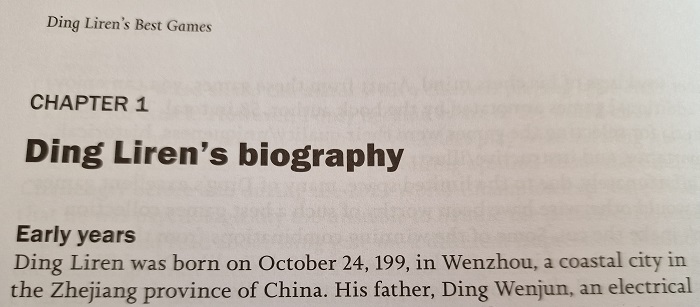
Alex Dunne (Sayre, PA, USA) points out that John Graham’s The Literature of Chess (published by McFarland in 1984) contains three different spellings of the same name: Neishstadt (page 46), Neischstadt (page 65) and Neishtadt (page 81).
Pages 339-343 of Kings, Commoners and Knaves indicated that in The Batsford Chess Encyclopedia Nathan Divinsky notched up several such trebles. Perhaps readers can inform us of similar (or worse) cases. Anyone with access to books by Dimitrije Bjelica will enjoy a head start.
(2770)
As reported on page 155 of Chess Explorations, a 1985 openings book by Eric Schiller had ‘Grüenfeld’, ‘Gruenfeld’, ‘Grünfeld’ and ‘Bruenfeld’.
(2779)
Concerning Raymond Keene in this domain, see C.N. 11864.
Black and White Evergreen by A. Matanović and J. Prokopljević (Belgrade, 2001), well-produced with many colour illustrations of high quality, is another book which has (on page 70) a position headed ‘Parr – Waitkroft, Holland 1968’. Page 82 offers the conclusion of what is allegedly ‘Deshapel – Laburdone, Paris 1837’.
Why are such books lavishly illustrated but not lavishly checked?
(2988)
Wonderful world of chess (published by ‘Chess press, Munchen’, undated) by D. Bjelica:

It comprises 191 pages of positions and anecdotal snippets. A position on page 175 is referred to as ‘Grief-Browne, El Paso, 1973’. White was Grefe, but in Mr Bjelica’s hands even prominent masters’ names come to grief. Examples (and there are dozens of others) are Bleckburne, Bogolybov, Durq, Eliskazes, Kochnoi, Marozy, Opancensky, Relstab, Restalb, Schelchter, Schelther, Schlehter, Tarasch, Teylor, Yeats, Zukertot and Zuckertot.
When on page 189, the correct spelling Schlechter capriciously occurs, the opponent’s name goes wrong (‘Tiz’ instead of Tietz). It is but poetic justice that another wayward speller, Koltanowski, should have his name mangled by Mr Bjelica (i.e. ‘Kolatnovki’ on page 183).
Regarding the pawn ending discussed on page 42 of A Chess Omnibus, Fahrni-Alapin emerges as ‘Fharvit-Alpin’ on page 25. Some of the position headings seem almost to have been written in code. Page 43 has ‘Snosko Borovski-Preis Remsget, 1929’. Another English seaside resort that defeats Mr Bjelica comes on page 167, in a game which ‘Cole’ (he means Colle) won in Scarborough. He writes ‘Scerborou’, and it might just as easily have been Scooby-Doo.
(3260)
A brief paragraph about linguistic skill on page 49 of Bjelica’s Wonderful world of chess compared ‘Ben Larsen’ to ‘Johanes Zukertot’ and concluded: ‘But Larse favourite player was not Zukertot but Nimzovic.’
(4747)
A (relatively brief) selection of examples of general carelessness in With the Chess Masters by G. Koltanowski: Page 9: ‘Mizowitch’ at London, 1922?? Page 10: ‘Giuco ... Pianisimo’. Pages 15-16: The best part of two pages are devoted to a story of how L. Steiner cheated against Colle at ‘the Budapest International, 1928’. Neither player was there. Page 48: ‘Twice Tarrasch mounted a campaign to take the world title from Lasker – and twice Lasker beat him badly.’ When was the second time? Page 49: ‘My first encounter with Dr Tarrasch was in 1924 at the International Chess Tournament in Merano, Italy. I was in my early teens.’ Yet he was born in 1903. Page 54: He appears to believe Scotland is in England. Pages 67-68: Another cheating anecdote, according to which Dyckhoff pretended only to have drawn against John at Hanover, 1902, so that his close rival Bernstein would not go for a win against Kagan. Yet Dyckhoff and John did only draw. Page 80 and page 81: ‘R.F. Mitchell’. Presumably R.P. Michell. Page 90: ‘James Cross’. Rupert Cross would be correct. Page 92: for (Emanuel) Sapiro read Sapira. Page 100: ‘Marotzy’ (twice). Page 101: ‘Bekker’ (twice). Page 101: Flohr did not play at Carlsbad, 1929. Page 101: ‘ ... ahead of Reifir, Spielman, Astalosh and the younger Widmar’. Read: a) Rejfíř, b) Spielmann, c) Asztalos, d) Vidmar. Page 101: Alekhine and Euwe did not play at Moscow, 1935 (it is even said that there Menchik ‘beat Euwe twice!’). Page 141: Rejfíř has a wrong year of birth. And so on ...
In an article on page 195 of the September 1971 Chess Digest Magazine William Winter was given the Koltanowski treatment:
‘Winter was a heavy drinker and one of the best chess stories I know is the one of the committee that was formed in 1927 just before the International tournament was to take place in London. They raised one hundred pounds (about 350 dollars then) to support William Winter, so that he could win the event with great ease. In the first round William Winter came into the playing hall, breathing harshly and he beat the great Richard Reti. The next day, Winter weaved into the playing room, sat down at his board and beat the perplexed Aron Nimzowitch. The third day Winter staggered to his seat and beat my co-patriot, Edgar[d] Colle. It looked like it was going to be a big triumph for British Chess. But the expectations were short-lived. Winter had spent all the raised funds on booze in the first three days, and the so-called Winter Committee couldn’t raise another penny from its supporters. The first prize was only one hundred pounds! William Winter arrived sober for each round after the third and lost every game.’
Let us, firstly, compare the above with the complete record of the tournament given in M.A. Lachaga’s comprehensive book on the event, published in 1968. William Winter’s round-by-round performance was as follows:
1: lost to Fairhurst
2: beat Buerger
3: beat Thomas
4: drew with Marshall
5: lost to Bogoljubow
6: drew with Yates
7: lost to Tartakower
8: beat Nimzowitsch
9: drew with Colle
10: lost to Réti
11: beat Vidmar.
This placed him among the prize-winners, i.e. equal sixth with Réti. He did not defeat Réti or Colle; nor did he play in the first three rounds any of the masters named by Koltanowski. About the alleged ‘Committee’, we know nothing, but it may be wondered who would put together £100, or any other sum, so that W.W. could win ‘with great ease’ a tournament which included Bogoljubow, Marshall, Nimzowitsch, Réti, Tartakower and Vidmar. Moreover, £100 (the amount which, Koltanowski alleges, was spent on alcohol consumption within three days) was then roughly $500, not $350. In today’s money it would come to over $5,000. Finally, the first prize in the tournament was not £100 but £50 (BCM, August 1927, page 335).
Thus every verifiable ‘fact’ in Koltanowski’s yarn is false. Why? Was he guilty, once more, of ‘mere’ sloppiness and doltishness (page 341 of the September 1922 BCM was certainly inspired when it spelt his name ‘Klotanowski’) or was there also a darker side to his compulsive fabrications? William Winter was indeed known to drink heavily, but what sort of human being would, in ‘one of the best chess stories I know’, publicly ridicule a deceased master for alcoholism without making the remotest effort to be truthful?
(3624)
The most inconsequential and empty chess volume in our collection is The End Game by Marvin Howard Albert (Alexandria Press and Print, Seattle, 1966). The entire contents, page by page, are as follows:
Front cover
Blank
Blank
Blank
Title page
Blank (except for copyright notice)
Blank
A 15-line poem
Blank
An eight-line Lasker quote and part of a chess design
Title (The End Game) and part of a chess design
Blank
A 14-line poem
Blank
Blank (except for a notice that the print-run was 22 numbered copies)
A four-line quote from “Herman (sic) Hesse”
Blank
Blank
Blank
Back cover (caption for an Alekhine v Capablanca position, with the diagram missing).
The End Game being eminently discardable, we wonder whether many of the 21 other copies are still extant.
(3287)
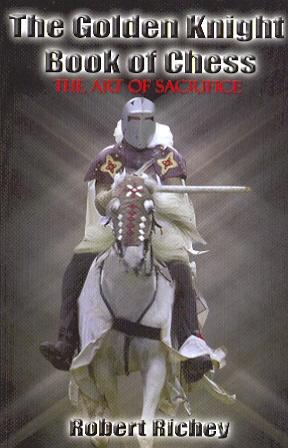
For the benefit of readers who prudently refrain from acquiring The Golden Knight Book of Chess by Robert Richey (Bloomington, 2005), two passages are quoted below. The first, from page xi, is part of the author’s explanation of the history of chess and some other games, such as golf and football. Regarding the latter he writes:
‘There is evidence to believe that Football it’s inception back in 1670 A.D. in Ireland. Therefore it has been around the about 334 years.’
On page 151 the solution to a chess puzzle begins with some golden advice:
‘Yet another seeming hopeless position. This is why in Chess to always analyse even in desperate circumstances for there are many time when the opponent poses the greatest threat at the same time may be the most vulnerable.’
(4064)
Although Ajedrez La lucha por la iniciativa by Orestes Aldama Zambrano (Barcelona, 2000) refers to Fisher and Meking on the first page of text, it is a monograph on Capablanca. His opponents include Atkeens, Berstein, Bofoljubov, Corso, Kreymbour, Kupnich, Kvitz, Rogoljubow, Rubistein, Spielman and Tartakowwer, and all this may be termed ‘doing a Bjelica’.
(4458)
In The Times of 12 March 1994, page 31 [S1] Raymond Keene stated that there was a grandmaster named Archangelski. After we pointed out this inaccuracy to the newspaper, a letter dated 24 May 1994 from the Deputy Managing Editor, Mr David Hopkinson, forwarded to us Mr Keene’s response:

(Kingpin, 1994)
Why do so many biographical monographs contain elementary blunders and attach little attention to basic presentation? For example, Paul Morphy, partidas completas (Madrid, 1993), a pitiful ‘bilingual’ Spanish/English book by Rogelio Caparrós, is rife with factual mistakes, typographical errors and faulty language. Magic Morphy by Chély Abravanel and Philippe Clère (1994) twice claims that its subject died in 1886, instead of 1884.
Aljechin, der Grösste! by Egon Varnusz and Arpad Földeák (Velten and Düsseldorf, 1994) goes wrong on the master’s birth date and, even, on the moves and dates of a number of his most famous games.
On page 141 of Pour Philidor (Koblenz, 1994) C.M. Carroll claims that ‘during the first half of the twentieth century, Philidor was not a well-known figure in history. As far as I can determine, the 200th anniversary of his birth in 1926 went by totally unnoticed ...’ To give just one straightforward refutation of that, the October 1926 BCM had a two-page article on Philidor by John Keeble whose first sentence referred to the bicentennial.
The ‘Champion Endgame Series’, published in the United States by Sergey Akhpatelov and Stephen Gordon, consists of monographs on Steinitz, Lasker, Capablanca, Alekhine and Euwe, with more threatened. Steinitz’s forename is misspelled (‘Willhelm’) on the front cover of volume 1. The other books have a few lines of career information, seldom accurate. Lasker’s death date is wrong. Capablanca’s 1921 score against Lasker is incorrect, as are Alekhine’s birth and death dates. We learn that Alekhine ‘died March, 25 1946 in Portuguese’ and that he won in 49 large toutnaments’ [sic]. Lasker ‘won in 13 large toutnaments’ [sic]. Twice in the Euwe volume (once on the front cover) the Dutchman’s year of death is given as 1986, instead of 1981.
(Kingpin, 1995)
Which is the recent book with the largest quantity of incorrect data for old games? Probably The Quickest Chess Victories of All Time by Graham Burgess (published by Cadogan Chess). To give (at least for now) just two examples: there is multiple imprecision in the Capablanca game on page 160, and page 67 has a game with the wrong name for Alekhine’s opponent, the wrong year and the wrong conclusion. Indeed, given its true length, that Alekhine game should not be in the book at all.
(2226)
Mikhail Tal died in 1992, but even reporting that elementary fact has proven an insurmountable hurdle for a number of writers. Other years proposed include:
1991: Larry Evans on the ‘Chess master Network’ (Internet).
1993: Graham Burgess on page 496 of The Mammoth Book of Chess.
1994: Bjarke Kristensen and Don Maddox on page 19 of their book about the Kasparov v Anand match.
Not to be outdone, pages 50 and 368 of World Champion Openings by Eric Schiller refer to a game ‘Unzicker v Tal, Hamburg, ...1996’.
(2240)
Our recommendation in C.N. 3514 was ‘to dispense with any publication or website which offers “chess quotes” without indicating where and when the statements in question were purportedly made’. From our recent reading, nothing in this field compares with the quotes section (pages 155-169) of Check Mate and Word Games by Carlos Tortoza (Denver, 2006). A sample follows:
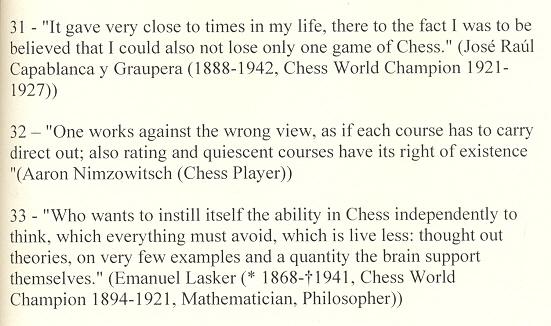
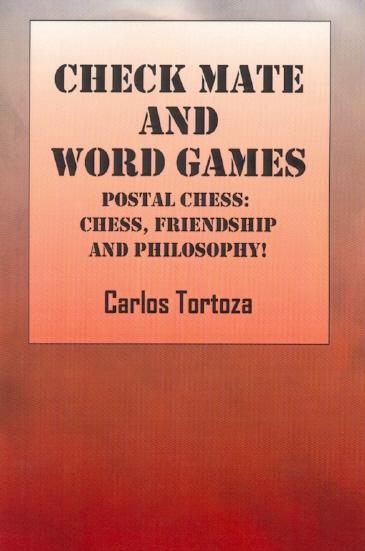
Sourceless quote-dumps are bad enough, but who would bring out a book with such an unmistakable (Germanic) reek of computer translation? A child, perhaps? The back cover provides some biographical information about Carlos Tortoza, who is Brazilian:
‘He is a psychologist and economist, with a postgraduate degree in economic projects, specializing in psychoanalysis. He is an academic professor of psychology, philosophy, sociology and economic business administration.’
(4716)
See too C.N.s 9025 and 10536.
Published in 1988 by colección Ricardo Aguilera (Madrid), Morphy su vida y 353 partidas by Benito López Esnaola claimed to be an important work of scholarship. As noted in C.N. 1821, the author commented in his introduction: ‘Morphy’s games have been compiled before, but I believe that the present book breaks the record with 353. The previous total was 300.’ The back-cover blurb remarked that 353 was a ‘record figure’ and trumpeted López Esnaola as ‘an excellent investigator of chess history’.
Our earlier item mentioned that such words were considerable exaggerations. Maróczy’s book on Morphy (first published in 1909) contained over 400 games, even though López Esnaola mentioned this predecessor on page 26. On the other hand, he overlooked the second series of unknown Morphy games published by David Lawson in the BCM (September 1979), and showed no evidence of acquaintance with Paul Morphy The Pride and Sorrow of Chess. There were so many misspellings they could hardly be printers’ errors. Pages 18, 26 and 35 referred to the ‘Britisch Chess Magazine’, no doubt by analogy with the ‘Britisch Chess Review’ (page 172). Staunton’ column was in the ‘Ilustration London’ (page 14), the ‘Ilustrated London News’ (pages 15, 16 and 172) and the ‘Ilustrated London’ (pages 17 and 18). Other nineteenth-century revelations were ‘McConnel’, ‘Rouseau’, ‘La Bourdonais’, ‘Lichtenthein’, ‘Lichtentheim’, ‘Lichtenheim’, ‘Lyttleton’, ‘Lytleton’, ‘Harwitz’, ‘St Jame’s Chess Club’, ‘Ilustrated Sportin and Dramatic News’, ‘MacDonnel’ , ‘Zukertot’ , ‘Andersen’, ‘Cuningham’, ‘Sucre’, ‘La Palamede’ and ‘Delandy’.
In addition, López Esnaola’s book concluded with six pages of biographical notes on Morphy’s opponents. They were simply purloined from the footnotes in Morphy’s Games of Chess by P.W. Sergeant.
(5195)
On page 234 of Treasure Chess by Bruce Pandolfini (New York, 2007) the remark about life being too short for chess is ascribed to both Lord Byron (1788-1824) and Henry James (1843-1916), instead of Henry James Byron (1835-1884).

(5280)

Page 14 of The Immortal Games of Capablanca by F. Reinfeld (New York, 1942)
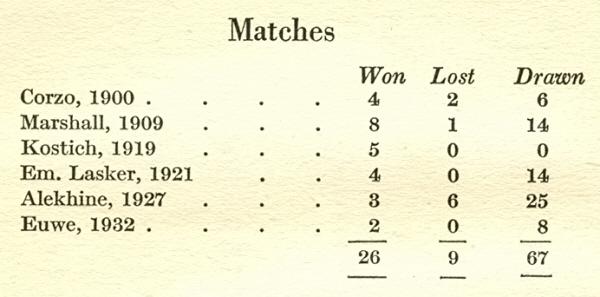
Page 20 of Capablanca’s Hundred Best Games of Chess by H. Golombek (London, 1947)
In the Lasker match there were ten, not 14, draws. The Euwe match was in 1931, not 1932. The only matter on which the books disagree is the year of Capablanca’s match against Corzo, and both are wrong. It was played in 1901.
The two books have been the subject of modern reprints which have not bothered to correct these (and innumerable other) elementary mistakes.
(5904)
Golombek had a longstanding difficulty in relating correctly the basic facts of Capablanca’s record, and C.N. 1406 shows how a concentration of errors remained in successive editions of another book of his.
On page 220 of The Game of Chess (Penguin) Harry Golombek writes of Capablanca: ‘In 1905 he beat Marshall by +8 –1 =14; in 1919 he beat Kostich 5-0; in 1921 he won a world championship match against Lasker by +4 –0 =14 and in 1932 he beat Euwe by +2 –0 =8.’
a) for 1905 read 1909; b) for =14 in the Lasker match read =10; c) for 1932 read 1931. We pointed out this concentration of errors on page 11 of the October 1976 CHESS, but no corrections were made in the third edition of the book (1980, reprinted 1986, page 222). Nor is the right information given in the French translation of the book (published by Payot).
The back cover of the latest Penguin edition says that since 1954 The Game of Chess ‘has sold over a million copies and the text has been revised and updated’.
See Harry Golombek’s Book on Capablanca.
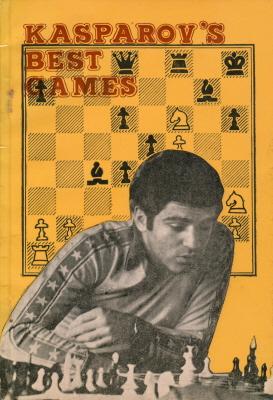
There cannot be many chess books more liberal with typos than Kasparov’s Best Games by K.R. Seshadri (Madras, 1984). The first word of the Preface gives Kasparov’s forename as Carri, and the first two paragraphs have occurrences of Kasperov. Overleaf, the forename becomes Gerry. The annotations, taken from the writings of Kasparov and others, are continually mutilated. Here, from page 46, is part of a note to White’s 15th move in Korchnoi v Kasparov, Lucerne (‘Lucerene’), 1982:
‘Hewever, the problamatic ideal manouvre 21 Nc4! suggested by Yugoslav Grandmaster Kovachevic put an end to the theoratical arguments n favour of White.’
(6042)
Leafing through The Vienna Game & Gambit by A.E. Santasiere and Chess Digest (Dallas, 1974), we became acquainted with such players as Bodin, Bogatzrtschuk, Bogolgubov, Charovsek, Golombeck, Hampoe, Hartson, Mettner, O’Kelley, Pincus, Polugaousky, Schallop, Schiffeis, Spielman, Stork, Sxabo and Weenimk. There are also instances of Adam’s, Barne’s and Schiffer’s, as well as the places Barman, Cortmund and Edinburg. Page 14 refers to a game between Mieses and Chigorin whose occasion was ‘Monte Car10 1002’, and page 70 discusses the game ‘Alekhine and Nenarokov-Bernsten and Blumfield, Moscow 1964’.
(6240)
More from Cardoza: Tarrasch was Russian; Steinitz was German; Francois Philodor wrote Analyse des Eschecs; Lasker published little; Capablanca lost to Lasker in the last round of St Petersburg, 1914; there were 13 draws in the 1921 world championship match; after 1948 Michael Botvinnik held the world title ‘for a short while’ until he lost it to Smyslov.
This, and much else similarly awry, is in the brief chess section of Silberstang’s Encyclopedia of Games & Gambling by Edwin Silberstang (New York, 1996).
(6250)
José Raúl Capablanca by I. and V. Linder (Milford, 2010) stands out on one account only: its bibliography may be the most error-ridden ever published in a chess book. Although only four pages long, it features dozens of typos and other mistakes (with a far higher total if foreign accents are considered too). For an example we go no further than the first entry (on page 268):

No edition of Chess Fundamentals has contained an After ward (or Afterword) by Cherner (or Chernev). The book in question was My Chess Career.
(6642)
In 2006 there was an edition of Chess Fundamentals revised by Nick de Firmian which purported to improve on the text by giving the reader less Capablanca and more de Firmian.
Now, Emereo Publishing has brought out ‘The original classic edition’ of Capablanca’s work:
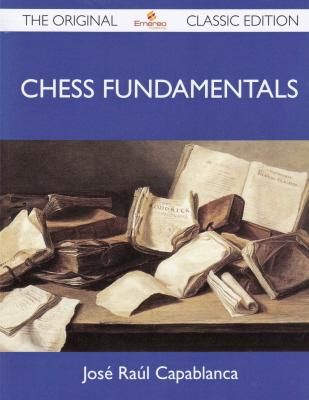
All the diagrams have been dropped, and the book is therefore unusable. For instance:
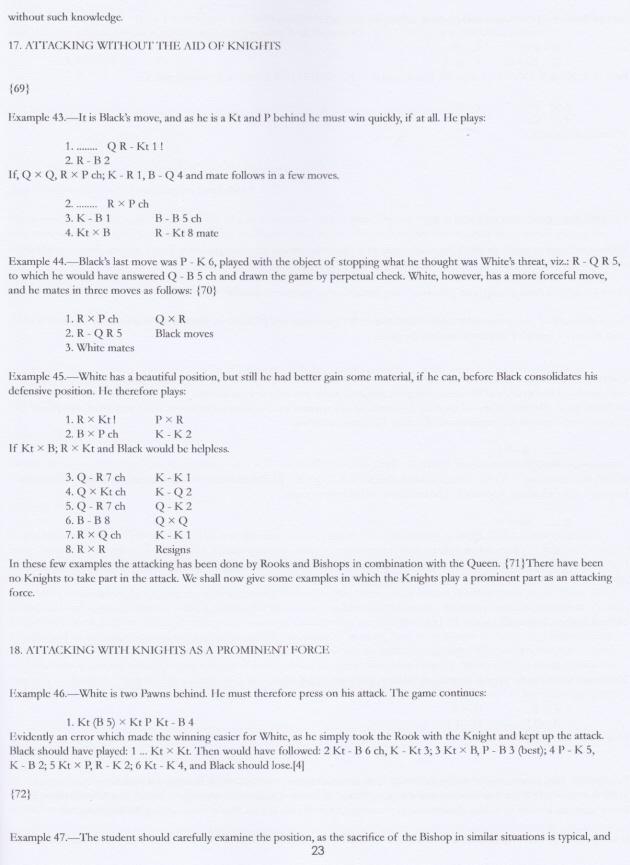
(7756)
¨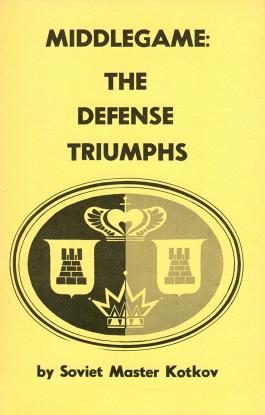
... A few remarks are offered about the booklet, which was published by Chess Digest. No original Russian edition was mentioned, and the lack of a forename, or even an initial, for the author may suggest just a routine Chess Digest error and that the author was Alexander Kotov. In fact, the booklet is an English translation (although we use both of those words loosely) of Zashchita torzhestvuet by Yury Mikhailovich Kotkov, published in Moscow in 1971.
The translator was named by Chess Digest as Roy DeVault. On account of another of his Chess Digest offerings he was pummelled by Kenneth Neat on page 42 of the November 1976 CHESS, and we quote the introductory paragraphs of that critique:
‘Middlegame Laboratory by Suetin has been translated from the Russian by a certain Roy DeVault.
A comparison of the translation with the original text makes it clear that Mr DeVault’s knowledge of Russian is virtually nil. He appears to guess at the meaning of a particular sentence, and, if this does not prove feasible, to ignore it altogether. Large sections of important material are simply omitted, and what is included is invariably inaccurate, frequently totally incorrect, and at times pure gibberish.’
In the Kotkov booklet, even well-known names go wrong. On page 3 the first proper name in the book, Форгач, comes out as ‘Forgall’, instead of Forgács. Pages 44-45 feature Capablanca’s loss at Moscow, 1925 to ‘Ilian-Janevsky’. (The next two pages have a game headed ‘Holmaio-Alekine’; White was Golmayo.) ...
(6851)

Concerning Alfil malo by B. Ivkov (Barcelona, 2002):
Certainly, prudence is required with the book, a Serbo-Croatian work translated into Spanish. Its overall unreliability may be gauged from some of the names featured: Edw. Asker, Dechapel (in a game against Labourdonet), Fisher (passim and, for instance, in the game D. Bern-Fisher), Korchno, Kreychik, Kreytschik, Mardhall, Nimzowits, Pilsburry, Schlehter, Semish, Shlechter (a game dated 1860), Smislosv, Spielman, Spilmann, Tall, Tarasch and Tarash.
(6653)
Koltanowski’s book Torneo internacional de Hastings 1935-1936 (Barcelona, 1936).
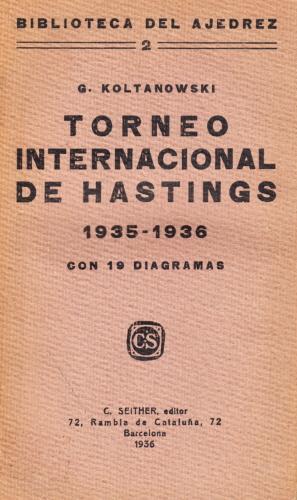
The Koltanowski touch is reflected in, for instance, the book’s references to Buenger, Friffith, Gensberg, Golombeck, Gross, Michel, Pire, Rubistein, Tartalkower, Vitmar, Womorsly, Wonorsly and even, on page 32, Koltanowki.
(7781)
As shown in our feature article, in Larry Evans book The 10 Most Common Chess Mistakes, page 45 (containing less than ten lines of text) has the following errors:
“Thomas – Mitchell”; Black’s name was Michell.
“London, 1932”; the game was played at the Hastings, 1932-33 tournament.
Wrong diagram, since the pawn at c5 should be black.
In his paragraph (a) Evans omits mention of the faster win 5 Re7+.
In his paragraph (b) he writes “Black actually lost”, whereas Black actually won.
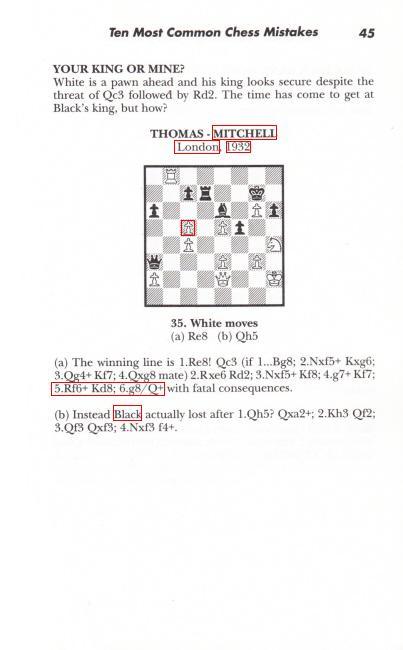
Then page 157 has an alleged position from the Marshall v Capablanca match of 1909 (5th game), with Evans claiming that, “incredibly”, White missed an immediate victory (mate or gain of the queen) through 45 Qe8+. Untrue, because Marshall’s queen was on b6, and not c6. This elementary matter has been pointed out countless times, and even by Evans himself on page 750 of Chess Life & Review, November 1974.’

Half a dozen typos in half a dozen lines.
Source: page 12 of a book published by Impala Film Division in 2008: Battle of Bonn (World Chess Championship 2008) by Raymond Keene and Eric Schiller.
(8142)
From page 57 of The Times Winning Moves by Raymond Keene and Byron Jacobs (London, 2003):
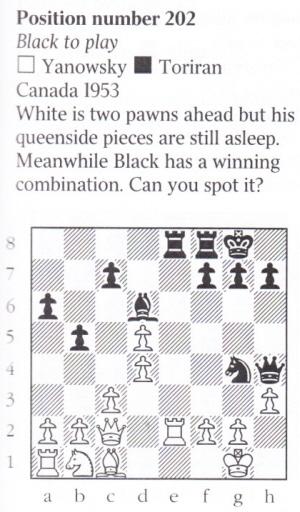
From Dan Scoones (Port Coquitlam, BC, Canada):
‘In citing a chess position it requires a very special talent to garble not only the venue and the date but also the surnames of both players – in other words, everything of significance apart from the actual position and the subsequent moves.’
(8175)
The correct information reference is Yanofsky v Tornerup, Copenhagen, 1947. For the details, see the additional text in C.N. 8175.
Page 42 of Evans on Chess by Larry Evans (New York, 1974):
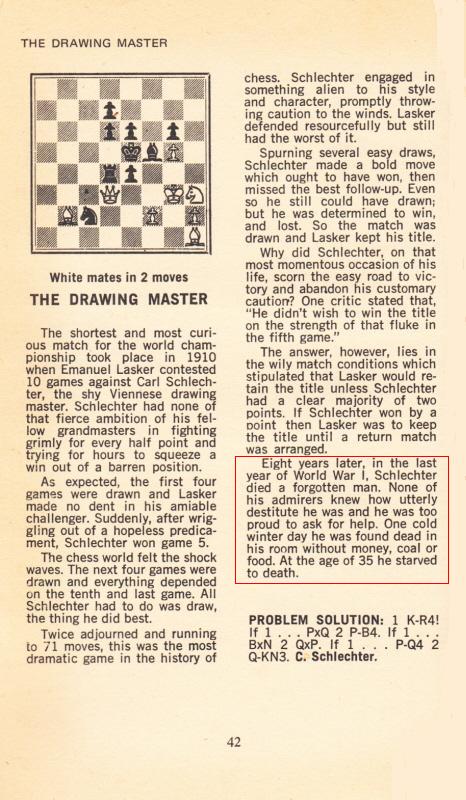
As regards the final paragraph, at the time of his death, in late December 1918, Schlechter was by no means ‘forgotten’; he was the Editor of the Deutsche Schachzeitung and in September-October 1918 had participated in a double-round tournament in Berlin with Lasker, Rubinstein and Tarrasch. His death occurred not ‘in the last year of World War I’ but after the War was over. Nor was he found dead alone in his room at home (which would mean in Vienna); he died in hospital in Budapest. The cause of his death is uncertain. He was then aged 44, not 35.
That syndicated column by Evans, riddled with errors though it was, was still appearing in newspapers nearly 15 years after its first publication (on, for instance, page D27 of the Chicago Tribune, 3 May 1987), without even a correction of Schlechter’s age.
(8222)
Below are the last two names on a list of challengers on page 279 of Keene On Chess by Raymond Keene (New York, 1999):

The respective dates should obviously be 1993 and 1995.
Mr Keene, though, stuck to his guns. From page 280 of his Complete Book of Beginning Chess (New York, 2003):

(8434)
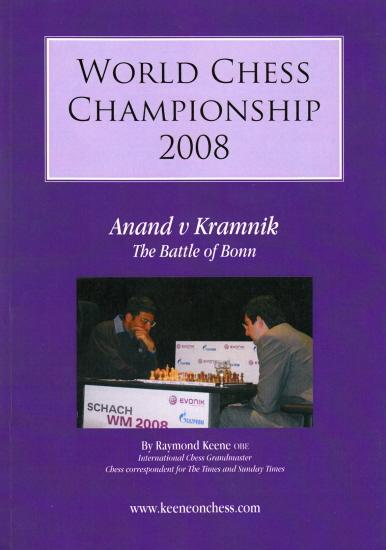
From page 98:

For Kramnik read Anand. For Topalov read Kramnik.
(8476)
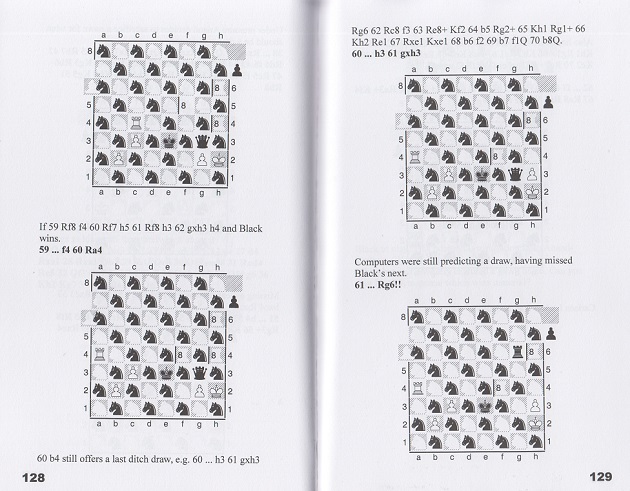
Above are pages 128-129 of Magnus Carlsen – Viswanathan Anand 2014 Re-Match for the World Chess Championship by Raymond Keene (Bronx, 2014).
The book has well over 100 similar diagrams.
(9046)
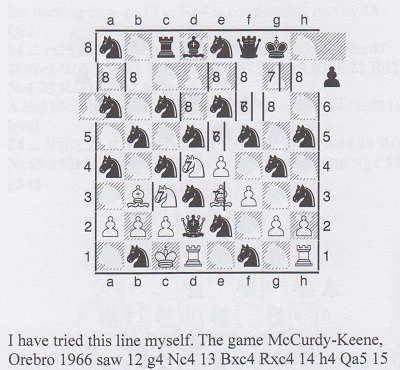
From page 105 of Chess Rules of Thumb by Lev Alburt and Al Lawrence (New York, 2003):
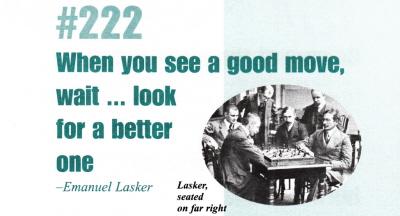
The advice attributed to Lasker is many, many centuries older, as shown in C.N.s 7837 and 7841. Nor should Lasker’s name appear in connection with the well-known photograph, which was the frontispiece to Der Schachwettkampf Schlechter-Tarrasch (Leipzig, 1912):
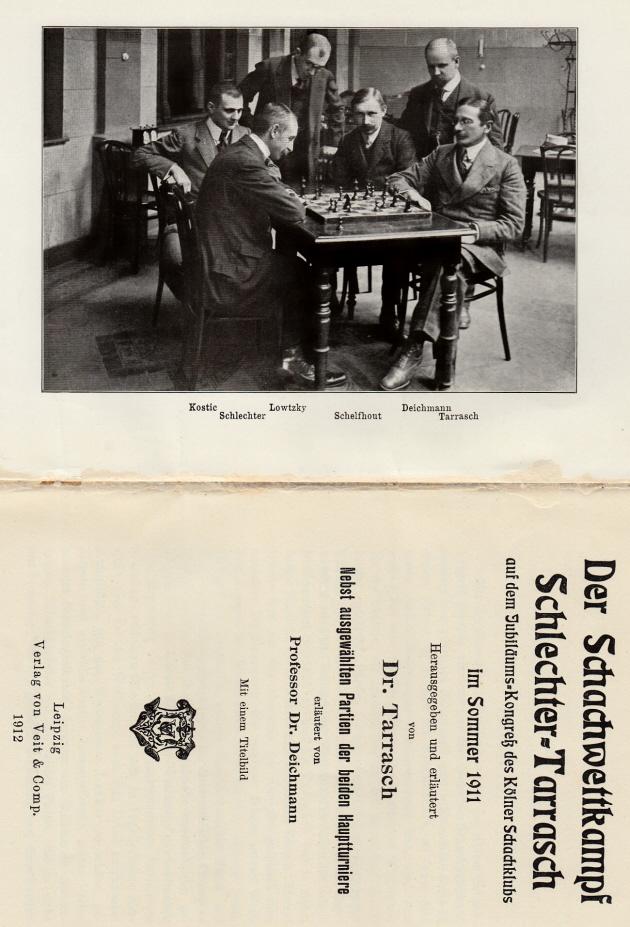
(8738)
See also Chess: ‘When You See a Good Move ...’
Two lines from page 73 of the ‘new 21st-Century Edition’ of The Art of Checkmate:

(9149)
Concerning the output of Christian Hesse, see C.N. 9459 (as well as The Chesswriting Practices of Christian Hesse), where a correspondent’s observations include:
‘Wrong position, wrong venue, wrong winner.’
‘Another position, but also wrong, and again the wrong venue and wrong winner.’
‘Once more, wrong position, wrong venue and wrong winner.’
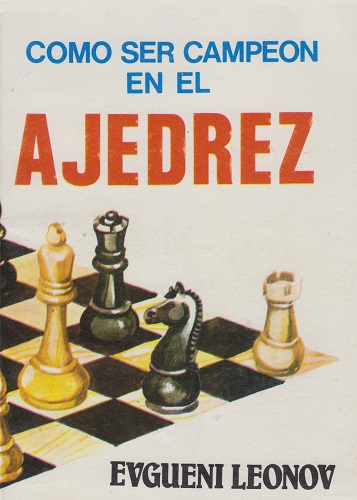
On pages 6-7 of Como ser campeón en el ajedrez by Evgueni Leonov (Mexico City, 1985) the list of world champions includes Murphy, Ewe, Aleknine and Boltvinik. The last two names are Eddie Fischer and Boris Karpov.
(10023)
Concerning the McFarland books of Gino Di Felice, see Chess Jottings.
Vlastimil Fiala, the Quarterly for Chess History Editor (whose name appears 14 times [in volume 18] in the ‘Content’ – alongside only four other contributors), provides a reminder of his own level of competence. From page 445:
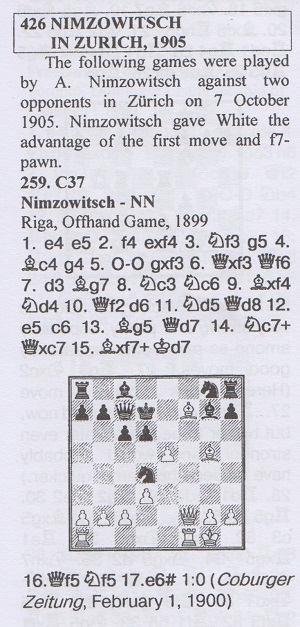
Despite the introductory word ‘games’, there is only one game-score. It was not played by Aron Nimzowitsch, or against two opponents, or in Zurich, or in 1905, or at odds.
The game, won by the master’s father, Schaie Niemzowitsch, was given in C.N. 683. As noted on page 52 of Kings, Commoners and Knaves, it was published on page 77 of Schachjahrbuch für 1899, II. Theil by Ludwig Bachmann:
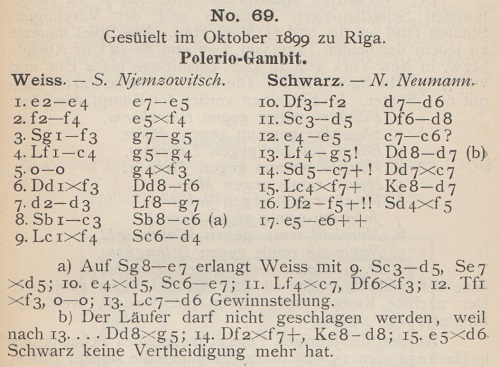
(10571)
For more information about the Quarterly, see Chess Jottings.
David Abrams (Syracuse, NY, USA) points out page 180 of Pandolfini’s Endgame Course by Bruce Pandolfini (New York, 1988):

(10516)
Olimpiu G. Urcan (Singapore) draws our attention to his review of the e-book Carlsen v Caruana: FIDE World Chess Championship, London 2018 by Raymond Keene and Byron Jacobs (London, 2018) and sends us half a dozen lines from the book’s ‘History of the World Championship’ section:

We offer a few comments:
Even without primary sources, a quick glance at, for instance, The Oxford Companion to Chess by D. Hooper and K. Whyld (Oxford, 1992) would have sufficed to avoid all these elementary blunders.
(11126)
Now we quote from Raymond Keene’s Article dated 30 July 2022:
‘Anderssen can claim to be one of the supreme tacticians of all time. Three of his wins are of imperishable beauty. On their own they would justify anyone’s devotion to chess. They are his Immortal Game against Kieseritsky (played at Simpsons-in-the-Strand, not the tournament) of London, 1851; his Evergreen game against the pseudonymous Dufresne (in reality the German player E.S. Freund) of Berlin 1856, and his majestic sacrificial masterpiece against Zukertort of Breslau, 1869.’
Based on a very short browse, below are some extracts from Chess Problems, Play and Personalities by Barry Martin (Beddington, 2018).
The start of an article about Alekhine on pages 41-43:
‘... his father was a landowner, a Marshal of Nobility, and a member of the Russian Duma. His mother was an heiress to an industrial fortune. Alekhine became addicted to the game of chess at the age of 11 ...’
This brings to mind page 5 of The Oxford Companion to Chess by D. Hooper and K. Whyld (Oxford, 1984):
‘His father was a landowner, a Marshal of Nobility, and a member of the Duma, his mother heiress of an industrial fortune. ... Alexander became addicted to the game at the age of about 11 ...’
Similarly, pages 194-195 (the section on Leonard Barden) are little more than pickings from his Wikipedia entry.
Sometimes, though, Mr Martin is self-reliant. From page 70:
‘Howard Staunton, the only English chess player ever to have held the title of World Champion by winning against the generally accepted World Champion, St. Amain in Paris in 1843 ...’
Page 81 discusses St Petersburg, 1914:
‘The combatants in the main tournament were the leading lights at that time of world chess, five of whom had played in a pre-tournament which included 11 players to the main tournament in St Petersburg.’
Page 269 states that Capablanca ...
‘... taught himself the game of chess at the age of 13’.
(11186)
From C.N. 11022:
‘I’m not good at attention to detail’, stated Mr Keene uncontroversially on page 17 of the November 1990 CHESS.
A brief article by Olimpiu G. Urcan illustrates this.
Pages 563-571 of the latest edition (‘Spring 20/2019’) of the Quarterly for Chess History are devoted to a review-cum-demolition by the Editor, Vlastimil Fiala, of Vera Menchik by Robert B. Tanner (Jefferson, 2016). The final paragraph states that the book ‘should never have gone to print’.
As mentioned in C.N. 10191, the Menchik book is indeed very weak, but with his own track-record Vlastimil Fiala is an unsuitable person to complain, as he does on page 570, that it has ‘a large number of typos’. The review itself includes ‘J. Kaledovský’, ‘St Leonard’s’ (four times), ‘Bell’s of London Life’, ‘Sir G.H. Thomas’, ‘E. Eales’, ‘L’Echiquer’ (twice), ‘Hastings 19028/9’ and ‘Carslbad’.
Elsewhere, this new issue of the Quarterly contains, on pages 226-263, an article about Vienna, 1882 which refers to Berthold ‘English’, instead of Englisch, nine times. Pages 300-311 present some games played by Staunton in Scotland with the misspelling ‘Edinburg’ 12 times. On page 387 a game lost by Alekhine is dated ‘11.12.2930’. A sentence on page 420 refers to ‘Casablanca’ and ‘Miss M.T. Morra’.
(11232)
The Introduction (page 5) to Play Like a World Champion José Raúl Capablanca by Bill Jordan (‘Amazon Fufillment’, Wrocław, 2019) begins with a paragraph which was considered good enough to reproduce on the back cover:

(11664)
From Cuttings:
On 18 May 2019 Olimpiu G. Urcan informed us that his review of the 2018 Carlsen v Caruana match book had prompted an 11-page article by Jimmy Adams in the May 2019 BCM (pages 297-307) which attempted to defend Raymond Keene – incompetently, with, for instance, 23 occurrences of the misspelling ‘Olympiu’.
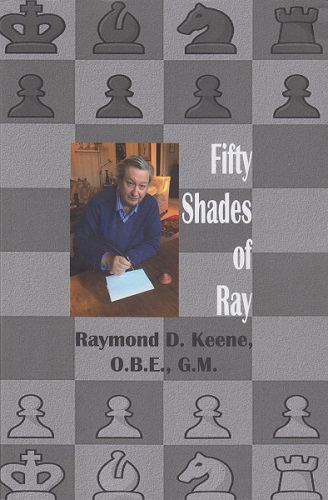
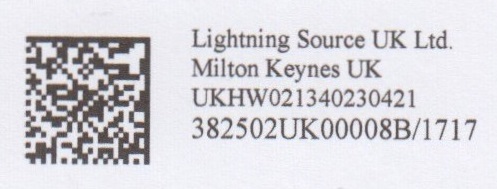
On 18 May 2021 we added to Cuttings the remark below concerning a book compilation of material by Raymond Keene most recently published in The Article and in the BCM (though often in other unnamed places previously):
We skimmed the chess content of Fifty Shades of Ray for about an hour, ignoring all the recycling and re-recycling of games. With a tally of over 100 errors, misspellings, typos and inconsistencies we gave up in disgust.
Now, a few days later, a second reluctant examination has revealed, unsurprisingly, a vastly higher tally.
It is a calamitous book, even by Raymond Keene’s standards. A dozen or so proper names are spelt two or more ways, and in some cases on the same page (e.g. Loewenthal and Löwenthal on page 32, and Lowenthal on page 44); page 42 has both Vinyoles and Vinoles, concerning a game whose first note says that White ‘could have plated 6. Bx7+’. General editing, lay-out, punctuation, italicization, etc. are a fiasco. Already on pages ix-xii, the list of contents and the list of games have dozens of mistakes. Elsewhere there is the amateurish spectacle of a comma at the beginning of a line, and a line consisting of some 65 letters with no spaces between words. On page 128 Raymond Keene professes an academic knowledge of French, but nearly 20 French words and names are rendered inaccurately in the book. The only picture, occupying half of page 266, is the top part of a tournament crosstable; it is illegible.
Some sections gave us the impression of being the first person ever to read, or even skim, them in their current form, despite Raymond Keene’s affirmation in the Introduction that the columns have been edited (by C.J. de Mooi) and proofread (by Julian Hardinge). The Introduction also expresses thanks to four family members ‘for invaluable assistance in honing the original contributions from which this volume is composed’. Goodness knows what the unhoned versions looked like.
C.J. de Mooi’s syrupy Foreword could easily be picked apart, but here we quote just one paragraph:
‘... that old enemy time moves inexorably forward and the old are usurped by the young. After over three decades as the chess correspondent for both The Times and The Spectator he was unceremoniously replaced.’
This echoes Raymond Keene’s own untruthful and ungrammatical words on his Twitter page, 31 July 2020 (quoted in full in Cuttings):
‘I am 72. Last year, at the age of 71, both The Spectator and The Times fired me after respectively serving for 42 years and 34 years without missing a single column ...’
At present, therefore, it is The Article and the BCM that showcase, so to speak, his output, although large swathes of the output are input from past writings, copy-pasted with no attempt to rectify their obvious defects, even when they have been pointed out publicly.
Our feature article The Immortal Game (Anderssen v Kieseritzky) shows how, over the years, Raymond Keene has rehashed various factual blunders about the 1851 brilliancy. Far from taking account of chess historians’ investigations, discoveries, corrections and conclusions, Fifty Shades of Ray remains incompetent over the most basic matters: yet again, for instance, the players are named as ‘Adolph’ Anderssen (also ‘Andersen’ on the same page, where we find too ‘the Ruy Lopex’) and ‘Kieseritsky’. The game, incidentally, features a ‘gradiose’ combination.
The scrappy sections on Alekhine and the Nazi articles are illogical and self-contradictory. Raymond Keene, the antithesis of a chess historian, seldom offers sources, preferring bare assertion as if he, of all people, can be taken on trust. Page 109 has categorical statements about how exactly Alekhine died (which nobody knows) and when he died (‘on the evening of March 25, 1946’). As shown in our feature article on the subject, Alekhine’s death had been reported worldwide the previous day.
Sloppiness pervades Fifty Shades of Ray with, even, mistakes and inconsistencies in the names of Raymond Keene’s present publisher, present employer, former publisher and former newspaper; and in the titles of a book which he co-authored and one to which he contributed. To be liked by him is a burden carrying no guarantee of a correctly printed name, as Dominic O’Brien will find on page 207 (two mentions, both with typesetting mishaps).
Leaden repetition of titles is embarrassingly frequent (see, for instance, how Nigel Short has the misfortune of being referred to), and never more embarrassing or frequent than when Raymond Keene is presenting himself:
(11864)
From page 66:
Later on the same page, Diderot receives airier treatment:
Addition on 3 September 2024:
Some people publish material unworthy even of a note for the file.
Further reading:
The Ultimate Chess Playing Guide
Chess: Mistaken Identity
Missed Mates
Gaffes by Chess Publishers and Authors
Unintelligible Chess Writing
Hype in Chess
Chess: the Need for Sources
How to Write about Chess
A Chess Database
Chess Myths
Reuben Fine, Chess and Psychology
Chess Anecdotes
Chess and the English Language
Instant Chess
Larousse du jeu d’échecs
Cuttings (on Raymond Keene, OBE, Ctrl+C, Ctrl+V)
A Question of Credibility
Comic Relief: Raymond Keene and Chess Politics
An Indian Copying Mystery
Capablanca Book Destroyed
Warriors of the Mind
Dimitrije Bjelica – A Unique Chess Writer
Chess and Untimely Death Notices
Steinitz versus God
‘Fun’
Koltanowski
A Fake Chess Photograph
Worst-ever Chess Book?
Copying
Jaffe and his Primer
A Sorry Case
A Publishing Scandal
Chess Awards
Historical Havoc
A Catastrophic Encyclopedia
World Champion Combinations
Over and Out
The Facts about Larry Evans

To the Chess Notes main page.
To the Archives for other feature articles.
Copyright: Edward Winter. All rights reserved.